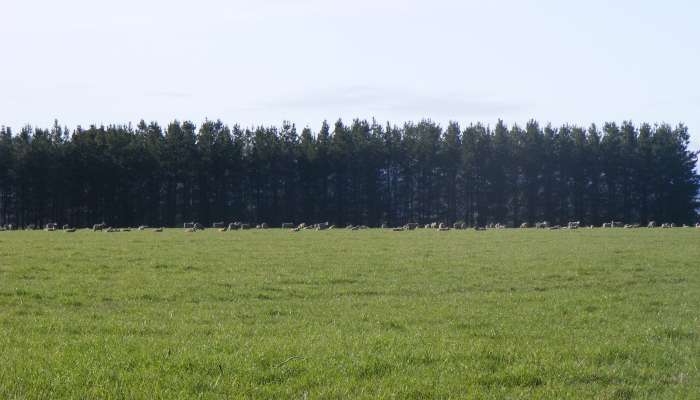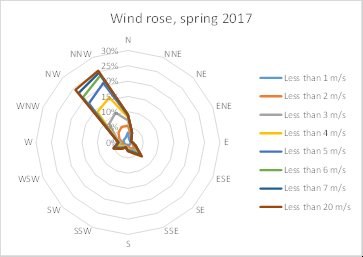Case Study - Agroforestry
5. Shelter increased pasture production by 30%
Formosa, Cressy - Pasture production in Spring 2017 was on average 30% higher in the sheltered half of a paddock compared to the unsheltered half. A Pinus Radiata shelterbelt occupied approximately 1ha of the paddock (4%) but induced a 15% increase in pasture growth over the remaining 24ha increasing pasture production to the equivalent of a 29ha paddock.
Download PDF
At a glance
| Owner | Family owned |
| Property name | Formosa |
| Location | Cressy, Northern Tasmania |
| Property size | 25 hectares |
| Enterprise | Dryland and irrigated mixed farming |
| Rainfall | 592mm |
| Soil type | Brown chromosol |
| Forested area | 1 hectare |
Key points
- Pasture production in Spring 2017 was on average 17% higher in the sheltered half.
- The 1ha shelterbelt increased the 24ha paddock to the equivalent of a 29ha paddock.
- Gross margin benefits are around $63/ha or $1,500 across the whole paddock.



Shelter increased pasture production by 30%
Formosa is one of four Tasmanian properties where the benefits of treed shelterbelts on pasture growth and the environment are being measured by PFT, CSIRO, and the University of Tasmania. In the spring of 2017, the stock was excluded from a Formossa paddock, and pasture was measured and mapped across the paddock using a GrassMaster Pro pasture biomass meter. The paddock is 500 x 500m, with a north/south oriented shelterbelt of Pinus radiata on the windward western edge. The shelterbelt was planted in 2001, with the trees being 17 years old with measurements showing the trees were 15m tall and 24cm at DBH. The shelterbelt contains around 250 m3/ha of wood. The porosity of the belt is around 30%. The paddock was a mixture of clover and cocksfoot which was 2 years old at the time, with the topography of the paddock being level.

Pasture Measurements
The paddock was grazed down to a relatively uniform starting point in the autumn and winter of 2017, and stock were excluded from the paddock in mid-August. The pasture was allowed to grow for around 7 weeks until early October. Pasture biomass was measured on October 3rd, 2017. A total of 7 transects running perpendicular from the shelterbelt were established across the paddock.
Pasture biomass was around 30% higher on the western (sheltered) half of the paddock (3.3 t/ ha) compared to the eastern (unsheltered) half of the paddock (2.6 t/ha; Fig.3). While pasture production was lower within the first 10 m adjacent to the shelterbelt, the shelter increased pasture productivity compared to the open paddock from 1.5 to around 12 tree heights (~22 to ~180 m) from the shelterbelt.
Image demonstrates the effect of shelter on biomass after seven weeks of stock exclusion in October 2017.
Wind
The wind at the site for spring 2017 was measured directly in an open unsheltered part of the paddock, where an automatic weather station continuously monitored wind direction and speed. The vast majority of the wind came from the NW and NNW (50% of all wind), another 9% of the wind came from the north, and 6% from the SE (Fig. 2). All other directions contributed to 5% or less of the total wind over this time period. The shelterbelt was close to perpendicular to the bulk of the wind and reduced wind speed on average by around 50% over the sheltered half of the paddock.

Value of shelter
Shelter lifted overall pasture production of the 24 ha paddock by approximately 15%, equivalent to the increase in hay yield, and/or the stock that can be carried on the paddock. If the gross margin of the grazing enterprise is $420/ha, and the increase of 15% productivity translated directly into gross margin, this would be increased by 15%, or around $63/ha, or an additional $1,512 over the 24 ha of the pasture. This effect is in addition to shelter benefits of increased stock survival and weight gain, as well as returns from wood sales when the shelterbelt is harvested, income from selling carbon credits associated with the net carbon increase from changing land use from pasture to trees, and increased land value.
Conclusion
The shelter belt at Formosa has conveyed a substantial benefit to the pasture production across the paddock, with 30% more pasture in the sheltered half of the paddock. One hectare of trees effectively increases the production of pasture from the paddock to the equivalent of a 29 ha unsheltered paddock. If this increase in pasture growth translated directly to the gross margin, it increased the net returns to the farmer from the paddock by around $1500. This is in addition to other benefits that the trees can provide, including timber production, carbon, biodiversity and amenity.
Acknowledgements
Daniel Mendham, Martin Moroni, Dale Worledge, David Bower, Arthur Lyons, CSIRO Land and Water.

